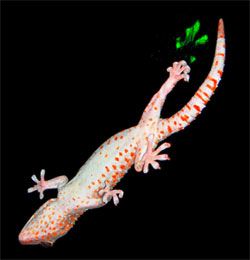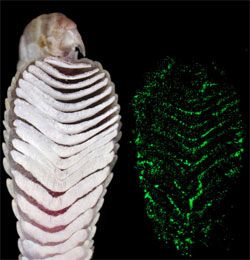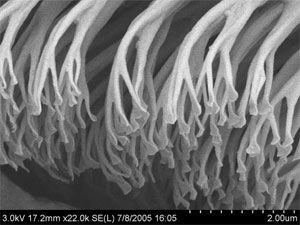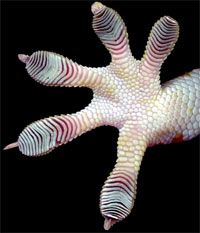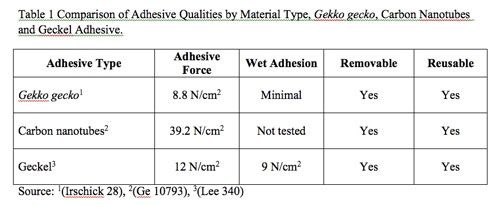Engineers are increasingly drawing on inspiration from other fields combined with creative problem-solving to construct the products of the future. The ability of the gecko to scale slick vertical surfaces has long been a fascination of biologists and scientists alike, with current engineers looking to harness this power to create new medical products. Three potential methods of engineering artificial gecko-inspired adhesives are examined here, with a focus on their possible medical applications.
Introduction
In the world of academics, creativity is often associated with the liberal arts; the public perception is that those who possess this innate characteristic are most successful as writers, sculptors, or artists. However, the ability to draw inspiration from the world around is a critical skill within the engineering disciplines as well. The biological aspects of the natural world is proving to be a fertile source for creative engineers: the strength of a spider’s silk pushes engineers towards improved cables and the evolution of burdock seed fertilization inspired the invention of Velcro [1]. Now the current boundaries of engineering and science are blurring in a push to replicate one of the most unique biological adaptations of all: the gecko’s incredible sticking ability (Fig. 1).
While the mind may immediately jump to the thought of climbing walls in special boots, gecko-inspired adhesives could be used in medical applications including “instant” sutures, improved waterproof bandages, and stitches to hold heart tissue together after surgery. In the process of developing these amazing applications, creativity does not end with the inspiration phase but continues through the various stages of design and implementation. Engineers are currently pursuing many different designs to achieve this goal, all inspired by the toe of the gecko.
The Gecko In Nature
The most specialized achievements of the gecko are its abilities to move easily across vertical surfaces and maneuver upside-down along horizontal ones. With the exception of Teflon, it hardly matters what surface a gecko wants to cross: it is able to scale the slickest glass surface with the same ease as a brick wall [2]. The Tokay gecko (Gekko gecko) is the largest of the geckos and can support an average of 20 kg while clinging to a nearly vertical surface. Given that Tokay geckos weigh, on average, only 0.5 kg and that their footpads have a surface area of only 2.5 cm2, this force is astounding [3]. The footprint of a Tokay gecko walking on an inverted surface is visible in Figure 1. The need to suspend such heavy, inverted loads is a challenge that was addressed long ago by structural and mechanical engineers by using everything from cables to well-placed systems of screws.
However, nature has taken this one step further. Despite the sticking power to support such weight, geckos are still able to move quickly and with great agility without being hindered by the adhesive forces of their feet – they can move at up to 10 steps per second [1]. Cables and screws either completely restrict movement or require a pre-designed system (i.e. tracks or rails) to incorporate this functionality. An easily reversible adhesive mechanism is more difficult to replicate with traditional engineering techniques. For instance, a system of electromagnets would provide the reversible mechanism, but would function only on select surfaces.
A final remarkable feature is that these sticky footpads don’t gather dust and grime, which quickly foul traditional glue-like manufactured adhesives. The footpads are almost entirely self-cleaning [1]. A successfully engineered replicate could revolutionize some of the most common medical tools, from sutures to skin grafts. But in order to synthesize such a replicate material, engineers must first understand how this biological material performs these functions.
The secret to the gecko’s success is in the structure of its footpads. Each pad is covered in lamellae – linear arrays of velvet-like material (Fig. 2), which, upon closer inspection, reveal closely-packed arrangements of hair-like setae (Fig. 3 and 4). These setae are made from keratin, the same material comprising human hair and fingernails. On average, each seta is less than 5 µm in diameter; a bundle of 400 setae would have the same cross-sectional area as the average human hair [4]. Yet these are not the smallest structures on the gecko’s toes. As seen in figure 4, each of these minute setae end in branches of hundreds of tendril-like spatulae only 0.2 µm in diameter. While this microscopic array is certainly an interesting evolutionary feature, understanding how it translates to sticking force is crucial in artificial designs.
Possible adhesion mechanisms vary greatly from substance to substance, ranging from molecular bonding to mechanical forces. The question is, which mechanism does the gecko use? To answer this critical question, Autumn et al. studied individual gecko setae to identify the most likely adhesion mechanism [4]. Previous research eliminated the use of friction, suction, capillary wet adhesion, micro-interlocking between setae and surfaces, and electrostatic forces as possible explanations [4].
Through a series of tests, Autumn produced fairly convincing results identifying van der Waals forces as the secret to adhesion. These forces occur when uncharged neighboring particles experience matching dipole fluctuations, in the presence of a slight positive-negative gradient. Although van der Waals forces are typically the weakest of intermolecular interactions, “they become significant when a large number of particles are involved” [5]. The minute size of the spatulae allow gecko footpads to come in very close contact with the surface material – close enough that van der Waals interactions can occur for a significant number of setae (Fig. 3). Therefore, the size, flexibility and large number of setae and spatulae may be the critical features necessary to replicate in an artificial material (Fig. 4).
The Gecko In Laboratories
With an understanding of how microscopic, branching pillars allow geckos to maneuver easily across ceilings and along glass windows, engineers set out to reproduce these mechanisms in laboratories around the world. However, a single starting point does not translate to a single possible solution. A wide array of possible designs have been developed, with only a few detailed here.
Carbon Nanotubes
A majority of synthetic gecko adhesives focus on replicating setae and spatulae with flexible and easily machined polymers and elastomers. However, with nearly all designs unable to match the performance of their biological counterparts, researchers at the University of Akron and the Rensselaer Polytechnic Institute took a different approach. They associated some of the failure of polymer pillars with the fact that the polymers are not nearly as strong as keratin. To resolve this, Ge, Sethi, Ci, Ajayan and Dhinojwal enhanced their design using one of the smallest but strongest nanomaterials – carbon nanotubes [6]. They experimentally determined that 50 micrometer wide and 200 micrometer tall carbon nanotubes aligned and attached vertically to a flexible tape could withstand up to four times the shear force loads of the natural gecko footpads. To replicate the spatulae aspect of the gecko, the researchers patterned the exposed ends of the nanotube pillars, resulting in a further increase in shear force capabilities. In fact, not only could this nanotube tape support greater shear forces on smooth surfaces, but it also experienced no degradation in adhesive ability over time and adhered comparably well to hydrophilic and hydrophobic surfaces. The additional critical feature of the gecko footpad is its ability to peel off from the surface with little energy expenditure. Although the required release forces were greater than previously used polymer pillars, the carbon nanotube tape could nonetheless be peeled off successfully without damage or loss of nanotubes, and then reused without loss of adhesive forces [6].
The carbon nanotube system provides an interesting solution to the issue of replicating and enhancing the adhesive forces of gecko footpads. However, despite mechanical and civil engineering possibilities, its use in medical applications is still questionable. First, Ge et al. did not investigate the shear force capabilities in a wet environment; with bodily fluids ranging from perspiration (for skin adhesives) to blood and digestive juices (for internal applications), wet-adhesive force is a necessity in the medical field [6]. Secondly, while no nanotubes remained on the mica, glass and Teflon surfaces after peeling off, the possibility of nanotubes interacting with and remaining inside soft tissue after tape removal will need to be studied.
Gecko + Mussel = Geckel
Researchers Lee, Lee and Messersmith addressed the challenge of wet-adhesive requirements by drawing further inspiration from nature (Fig. 5). They paired a masterful dry adhesion artist — the gecko — with the “celebrated biological model for wet adhesion” — the mussel, which uses an adhesive, water insoluble protein to attach tightly to solid objects underwater. A tape made of the organic elastomer poly(dimethyl-siloxane) (PDMS) was patterned with equally spaced pillars 400 nm wide and 600 nm tall, made of the same elastomer. Then the pillars were lightly coated with the synthesized adhesive poly(dopamine methacrylamide-co-methoxyethyl acrylate), or p(DME-co-MEA) patterned after the mussel adhesive protein.
The resulting adhesive was dubbed “geckel” as a tribute to its gecko and mussel inspiration. A variety of force measurements showed that this geckel tape outperformed the traditional gecko footpads in dry environments while wet adhesive forces were at more than 70% of this value. In comparison, the underwater gecko setae adhesive force is only 15% of the dry adhesive force. As with the carbon nanotubes, the geckel adhesive can be peeled off and reapplied; in this case researchers found that after more than 1000 adhesion cycles geckel material maintained 85% of its adhesion power in wet environments and 98% on dry surfaces [7]. This is a promising advance in the quest to fuse the worlds of geckos and medicine.
Combining the biological adaptations of two very different organisms allowed Lee, Lee and Messersmith to bypass the most significant limitation of the gecko’s footpads in a medical environment – poor adhesion to wet surfaces. Table 1 shows a comparison between the natural gecko setae, Ge et al.’s carbon nanotube design, and the geckel adhesive. However, the addition of an adhesive coating raises questions regarding the interaction of such substances with living tissue. Given that current adhesive bandages make use of semi-liquid coatings to stick to skin, this issue involves ensuring there are no dangerous reactions between mussel-styled coating and human tissue.
Perhaps the most promising medical aspect of the geckel adhesive stems from its underwater properties as this adhesion might allow for internal medical applications such as supplements to, or replacements of, sutures following internal surgery, even on internal organs such as the heart or muscle tissue. For example, during a carotid endarterectomy, surgeons open the carotid arteries in the neck to remove plaque buildup and then stitch the incision in the artery back together [8]. The two carotid arteries provide most of the blood supply to the brain so any post-surgery failure of sutures would have immediate and life-threatening implications. Supplementing the sutures with a layer of gecko-adhesive would provide additional support and backup to minimize the risks of complications associated with reclosing the arteries. Yet this too identifies an additional hurdle. Unlike simple skin sutures which can be removed, internal sutures are left in place until they eventually degrade or are absorbed by the body; the polymer of the geckel adhesive is not likely to do so. The indefinite presence of such a material within the body may ultimately create more complications than benefits. Engineers have found a solution to this problem as well.
Biodegradable and Biocompatible
Researchers ranging from the Massachusetts Institute of Technology to Harvard Medical School have focused their gecko-inspired research on developing adhesives specifically for use in vivo. They hoped to ensure that both biocompatibility and adhesion mechanics would not be altered by extensive tissue movement. They used silicon templates to mold a biocompatible and biodegradable organic elastomer based on poly(glycerol sebacate acrylate) (PGSA), thinly coated with the polysaccharide oxidized dextran aldehyde (DXTA), into pillar arrays with a variety of densities, heights, pitches and diameters [9]. Implanting patches of the adhesive on subcutaneous muscles indicated two important results. First, the material successfully maintained adhesion forces in living tissues with only a mild and acceptable level of tissue inflammation. Secondly, the degradation properties depended on the macroscopic structure of the adhesive sections and could therefore be controlled or designed, perhaps to continue to maintain the highest possible attachment forces even after significant degradation [9]. A final remarkable benefit of this biodegradable elastomer design was that drugs or other chemicals could be easily applied to the surface to further enhance treatment possibilities [9].
The Gecko In The Future of Medicine
Although Mahdavi et al. may be the closest to medical-grade adhesives of the three research groups profiled here, they are not following the only path. Every day, dozens of engineers and scientists combine forces to try new tactics to bring biological adaptations to the operating room. The challenge of developing a synthetic material that replicates gecko abilities – to cling tightly and instantly but to move freely – is sure to continue to provoke new and creative solutions. The opportunities for the medical industry could be quite significant. The speed of a simple tape to close wounds is a distinct advantage compared to the tedious process of suturing. High-risk areas for suture failure internally could be further supplemented by backup adhesives that degrade gradually as less and less adhesive force is needed. The currently accepted treatments for skin grafts and hernia treatments may someday evolve to include a little piece of the lizard world, maybe applying drugs and growth factors along with the necessary adhesion and protection. And who knows – with the endless creativity of the minds of engineers with the whole world at their fingertips, perhaps someday you will reach for “Gecko-Aids” from your medicine cabinet to close up those nasty paper cuts.
